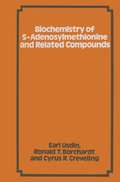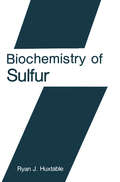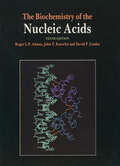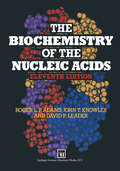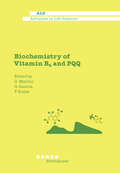- Table View
- List View
The Biochemistry of Retinoid Signaling III: Vitamin A and Retinoic Acid in Embryonic Development (Subcellular Biochemistry #95)
by Mary Ann Asson-Batres Cecile Rochette-EglyThis book covers subjects that have major impacts on society, such as the mechanism of maternal-fetal transfer of vitamin A, and the effects of alcohol on retinoic acid signaling and mammalian embryonic development. There has been an awareness of the importance of consuming vitamins throughout human history, but empirical studies of their physiological role and mode of action only began about 150 years ago. Since then, the biochemical nature of vitamin A and its active derivative, retinoic acid, have been identified and researchers around the globe have investigated retinoic acid’s physiological function in growth processes and in maintaining life Written by leading experts, this book discusses the latest findings and advances in retinoic acid research. It addresses topics such as the role of retinoic acid signaling in a multitude of processes, including limb, heart and respiratory system development, as well as its role in maintaining postnatal organ systems. This book is a valuable resource for scientists involved in vitamin A/retinoic acid research and readers interested in developmental biology.
Biochemistry of Scandium and Yttrium, Part 1: Physical and Chemical Fundamentals (Biochemistry of the Elements #13A)
by Chaim T. HorovitzBiochemistry of Scandium and Yttrium gathers together existing knowledge about scandium and yttrium from a wide variety of disciplines. Part 1 will present a comparative study of the physical and chemical properties of scandium and yttrium, looking at both their similarities and their differences. (Part 2 will address the biochemical aspects of these two elements, and the various medical and environmental applications.) While these elements are relatively rare in nature, these books will show that they have unusual physical and chemical properties, and a disproportionate number of important applications. Improved analytical techniques have revealed that scandium and yttrium are present throughout living matter, even though only a relatively limited number of species have been analyzed so far. This fact of course has far-ranging implications for biological and environmental concerns. Part 1 also contains a discussion of the interactions of scandium and yttrium with molecules of biological interest, such as organic acids, carbohydrates, proteins, nucleotides, and other biologically active molecules. The major impacts of scandium and yttrium in science, technology, and medicine will be of interest to a wide variety of researchers, including geochemists, inorganic and organic chemists, clinical biochemists, and those specializing in environmental protection. Biochemistry of Scandium and Yttrium, Part 1 and Part 2 will be especially welcome because the last book published on the biochemistry of scandium appeared over 20 years ago, and the only book mentioning the biochemistry of yttrium came out in 1990.
Biochemistry of Scandium and Yttrium, Part 2: Biochemistry and Applications (Biochemistry of the Elements #13B)
by Chaim T. HorovitzBiochemistry of Scandium and Yttrium gathers together existing knowledge about scandium and yttrium from a wide variety of disciplines. Part 2 addresses the biochemical aspects of these two elements, and the various medical and environmental applications. (Part 1 presents a comparative study of the physical and chemical properties of scandium and yttrium, looking at both their similarities and their differences.) While these elements are relatively rare in nature, these books will show that they have unusual physical and chemical properties, and a disproportionate number of important applications. Improved analytical techniques have revealed that scandium and yttrium are present throughout living matter, even though only a relatively limited number of species have been analyzed so far. This fact of course has far-ranging implications for biological and environmental concerns. The major impacts of scandium and yttrium in science, technology, and medicine will be of interest to a wide variety of researchers, including geochemists, inorganic and organic chemists, clinical biochemists, and those specializing in environmental protection.
Biochemistry of Signal Transduction and Regulation (Methods And Principles In Medicinal Chemistry Ser.)
by Gerhard KraussOriginally based on a graduate course taught by the author, this true classic has once again been extensively updated to incorporate key new findings in biological signaling. With over half of the content re-written, plus 70 brand new and 50 revised figures, this is the most up-to-date textbook on signaling available anywhere. Thanks to its clear structure, hundreds of illustrative drawings, as well as chapter introductions and newly added study questions, this text excels as a companion for a course on biological signaling, and equally as an introductory reference to the field for students and researchers. Generations of students and junior researchers have relied on "the Krauss" to find their way through the bewildering complexity of biological signaling pathways.
Biochemistry of Signal Transduction and Regulation
by Gerhard KraussOriginally based on a graduate course taught by the author, this true classic has once again been extensively updated to incorporate key new findings in biological signaling. With over half of the content re-written, plus 70 brand new and 50 revised figures, this is the most up-to-date textbook on signaling available anywhere. Thanks to its clear structure, hundreds of illustrative drawings, as well as chapter introductions and newly added study questions, this text excels as a companion for a course on biological signaling, and equally as an introductory reference to the field for students and researchers. Generations of students and junior researchers have relied on "the Krauss" to find their way through the bewildering complexity of biological signaling pathways.
Biochemistry of Signal Transduction and Regulation
by Gerhard KraussThis all-new edition of a classic text has been thoroughly revised to keep pace with the rapid progress in signal transduction research. With didactic skill and clarity the author relates the observed biological phenomena to the underlying biochemical processes. Directed to advanced students, teachers, and researchers in biochemistry and molecular biology, this book describes the molecular basis of signal transduction, regulated gene expression, the cell cycle, tumorigenesis and apoptosis. "Provides a comprehensive account of cell signaling and signal transduction and, where possible, explains these processes at the molecular level" (Angewandte Chemie) "The clear and didactic presentation makes it a textbook very useful for students and researchers not familiar with all aspects of cell regulation." (Biochemistry) "This book is actually two books: Regulation and Signal Transduction." (Drug Research)
Biochemistry of Signal Transduction in Myocardium (Developments in Molecular and Cellular Biochemistry #17)
by Jos M. J. Lamers Pieter D. VerdouwThe chapters in this volume are the Proceedings of the Satellite Symposium of the XVIth World Congress of the International Society for Heart Research on `Signal Transduction in Normal and Diseased Myocardium' which was held in Rotterdam at the Faculty of Medicine & Health Sciences of the Erasmus University, June 30 and July 1, 1995. Diverse and distinct auto-, para-, and endocrine stimuli arriving at the surface of endothelium, smooth muscle cells, cardiomyocytes and fibroblasts within the myocardium, engage cell type-specific receptors, which lead to transmission of signals across the cell plasma membrane and result in the production and activation of second messengers. The most common mechanism by which these second messengers function is via direct or indirect activation of specific protein kinases. The current challenge for scientists is to identify the specific substrates (e.g. metabolic enzymes, Ca2+-regulating proteins, transcription and mitotic factors) for the many protein kinases, to elucidate the biological significance of the cell type-specific expression heterogeneity of signalling proteins (e.g. membrane receptors, isoenzymes of protein kinase C, G-proteins) and to unravel the cross-talk interaction between the signalling systems (e.g. phospholipase C with adenylate cyclase and phospholipase C with phospholipase D). The multiplicity of receptor types, G-proteins, effector proteins, second messengers and protein kinases, their substrate proteins and the `cross-talk' interactions in the myocardium raises fundamental questions about the mechanisms that ensure the precision and timing of the myocardial responses to hormonal and pharmacological stimuli. This book provides an up-to-date source of information for all scientists and clinicians interested in the mechanisms by which external signals are transmitted to the interior and regulation of a variety of physiological, pathological and pharmacological responses.
Biochemistry of Silicon and Related Problems (Nobel Foundation Symposia #40)
by Gerd BendzSilicon chemistry was initiated in 1823 by Berzelius who prepared elemental silicon. In many ways silicon was considered a typical opposite of carbon, although the two elements are closely related as to their electronic structure, both having four valence electrons. The properties of their compounds are, however, extreme ly different. Both form extended structures, but in different ways - carbon by covalent carbon-carbon bonds; silicon by polar silicon- -oxygen-silicon bonds. The complex carbon compounds are integral parts of all living matter, plants and animals. The corresponding silicon compounds build up a major part of dead matter, soils and minerals. As recently as twenty years ago the title of this Symposium, "BiOChemistry of Silicon", would have been considered as contradictio in adjecto. However, the development in the field has, during the past fifteen years, been overwhelming and has convinced us that silicon is a necessary element in the life processes, for animals as well as for plants. Interesting therapeutical uses have been suggested, but we have also become increasingly aware of serious occupational diseases - asbestosis and silicosis - and of possible cancerogenic effects. It is our hope that this volume will give some idea about various aspects of silicon compounds which were discussed during the Symposium.
Biochemistry of Sulfur (Biochemistry of the Elements #6)
by Ryan J. HuxtableThere can be few elements with a biochemistry as coherent as that of sulfur. This important element is crucial to myriad aspects of metabo lism, catalysis, and structure. The plurality of functions in which sulfur is involved derives squarely from the numerous oxidation states in which it may exist, some having great stability, some being capable of ready redox interconversions, and yet others having great instability. As a result, the flux of sulfur from the geosphere through the various kingdoms of life leaves few biochemical processes unaffected. Although there are large gaps in the fabric of our basic knowledge of sulfur biochemistry, it is sufficiently framed to allow a unified and organized story, a story which many of the best-known names in bio chemistry have helped to write. It has been both a task and a privilege to try and summarize this story, one that is enormous, complex, fast moving, still developing and, above all, exciting. I suppose that no mo nographer of such a vast subject could be satisfied with his efforts. It is unfortunately probable that in attempting this task I have made as many errors as a Stilton cheese has blue streaks, and as many omissions as a Swiss cheese has holes. Perfection is not to be achieved in a monograph. Inasmuch as I have succeeded, the credit belongs to those whose efforts gave us the knowledge we have. Where I have failed, the fault is only mine.
The Biochemistry of the Carotenoids: Volume I Plants
by T. GoodwinThe carotenoids are not only amongst the most widespread of the naturally occurring groups of pigments, but probably also have the most varied functions; witness their known roles in photokinetic responses of plants, in phototropic responses of fish and as vitamin A precursors in mammals and birds. Pigments with such wide distribution and such diverse functions are obviously of great interest to biological scientists with very different specializa tions, especially as it is unlikely that the study of the functions of carotenoids is anywhere near complete. The primary aim of the present work is to discuss the distribution, bio genesis and function of the carotenoids throughout the plant and animal kingdoms in such a way that, because of, rather than in spite of its bio chemical bias, it will be of value to workers interested in all the biological aspects of these pigments. The biochemical approach is considered the most effective because, generally speaking, most progress in the study of carotenoids in living material has been achieved using biochemical techniques, be they applied by zoologists, botanists, entomologists, microbiologists or other specialists; what is even more important is that a consideration of the present position makes it certain that further fundamental progress will also be made along biochemical lines.
The Biochemistry of the Carotenoids: Volume II Animals
by T. Goodwindes Plantes (Hermann, Paris), and in 1935 by Lederer's Les Carotenoides des Animaux (Hermann, Paris). Since then a survey such as the present one has not appeared. In order to present a full picture, much of the pre-1934 work has been reconsidered and, as far as is known, every important contribution which has appeared since that date has been discussed. Two peripheral aspects ofthe subject have, however, been omitted, namely (a) the qualita tive and quantitative changes which the carotenoids of plant materials undergo in storage or during processing into food and (b) the carotene (pro-vitamin A) requirements of different animal species; it was felt that the former, about which a great deal has been written, was too technological to be suitable for inclusion in the present volume, whilst the latter is more suitable for a monograph on vitamin A. The very wide distribution of the carotenoids in Nature suggests that, in spite of the superficially diverse functions ascribed to them in different living tissues, there may be some factor or property through which all these functions will eventually be correlated; any suggestion as to the nature of this common property can perhaps come most readily from a comparative approach. Apart from critically surveying the literature this book has been constructed so as to focus attention on comparative data and their possible implications.
Biochemistry of the Elemental Halogens and Inorganic Halides (Biochemistry of the Elements #9A+B)
by Kenneth L. KirkThe elements in group 17 (VIlA) of the periodic table of elements-fluorine (F), chlorine (CI), bromine (Br), and iodine (I)-were designated by Berzelius as "halogens" (Greek hals, sea salt; gennao, I beget) because of their propensity to form salts. In this first of the two volumes of Bio chemistry of the Halogens, the biochemistry of the elemental halogens and inorganic halides is reviewed. Discovery, properties, and biochemistry of the elemental halogens are reviewed first (Chapter 1). This is followed by a review of the developments in the various areas of inorganic halide biochemistry (Chapters 2 through 5). The biochemistry of thyroid hor mones is considered in Chapter 6, while biohalogenation, an important link between inorganic and organic halogen biochemistry, is reviewed in Chapter 7. Chapter 8 covers the biochemistry of products produced by human-inspired halogenation, in particular, poly halogenated compounds that present environmental problems. In Chapter 9, the process is reversed and biodehalogenation is reviewed. In each subject, the attempt has been made to find an appropriate balance between depth and breadth of treatment, since a thorough, in depth review of this field would not be possible in a single volume. To provide readers not familiar with subjects with the necessary background to place subsequent discussions in perspective, brief historical develop ments of many of the topics are given.
Biochemistry of the Essential Ultratrace Elements (Biochemistry of the Elements #3)
by Earl FriedenThe remarkable development of molecular biology has had its counterpart in an impressive growth of a segment of biology that might be described as atomic biology. The past several decades have witnessed an explosive growth in our knowledge of the many elements that are essential for life and maintenance of plants and animals. These essential elements include the bulk elements (hydro gen, carbon, nitrogen, oxygen, and sulfur), the macrominerals (sodium, potas sium, calcium, magnesium, chloride, and phosphorus), and the trace elements. This last group includes the ultra trace elements and iron, zinc, and copper. Only the ultratrace elements are featured in this book. Iron has attracted so much research that two volumes are devoted to this metal-The Biochemistry of Non-Heme Iron by A. Bezkoravainy, Plenum Press, 1980, and The Biochemistry of Heme Iron (in preparation). Copper and zinc are also represented by a separate volume in this series. The present volume begins with a discussion of essentiality as applied to the elements and a survey of the entire spectrum of possible required elements.
Biochemistry of the Eye (Perspectives in Vision Research)
by Elaine R. BermanMy first introduction to the eye came more than three decades ago when my close friend and mentor, the late Professor Isaac C. Michaelson, convinced me that studying the biochemistry of ocular tissues would be a rewarding pursuit. I hastened to explain that I knew nothing about the subject, since relatively few basic biochemical studies on ocular tissues had appeared in the world literature. Professor Michaelson assured me, however, that two books on eye biochemistry had already been written. One of them, a beautiful monograph by Arlington Krause ( 1934) of Johns Hopkins Hospital, is we II worth reading even today for its historical perspective. The other, published 22 years later, was written by Antoinette Pirie and Ruth van Heyningen ( 1956), whose pioneering achievements in eye biochemistry at the Nuffield Laboratory of Ophthalmology in Oxford, England are known throughout the eye research community and beyond. To their credit are classical investigations on retinal, corneal, and lens biochemistry, beginning in the 1940s and continuing for many decades thereafter. Their important book written in 1956 on the Biochemistry of the Eye is a volume that stood out as a landmark in this field for many years. In recent years, however, a spectacular amount of new information has been gener ated in ocular biochemistry. Moreover, there is increasing specialization among investiga tors in either a specific field of biochemistry or a particular ocular tissue.
Biochemistry of the Lanthanides (Biochemistry of the Elements #8)
by Christopher H. EvansBy a happy coincidence, the completion of this text coincided with the 200th anniversary of the discovery of gadolinite, the mineral with which the lanthanide story begins. For a group of elements which occur in only trace amounts biologically, and which have no known metabolic role, the lanthanides have spawned a surprisingly large biochemicalliterature. Se rious interest in the biochemical properties ofthese elements can be traced to concerns about the safety of radioactive lanthanides toward the end of World War 11. As recent events at Chernobyl indicate, this concern re mains topical. However, the literature on lanthanide biochemistry pre dates the atomic era, beginning with sporadic, medically motivated studies in the latter part of the 19th century. Much of the present biochemical activity involving the lanthanides centers around their ability to provide 2 important information on the interactions of Ca + with macromolecules and with eukafyotic cells. With the increasing industrial use of the lan thanides, their toxicological properties will need to be examined more closely. Rare earth pneumonoconiosis has already been identified as a disease produced by industrial exposure to lanthanides. Several of the biochemical properties of the lanthanides are of relevance to modern medicine. Already cerium-based ointments are used to treat burn wounds, while paramagnetic lanthanides find application in nuclear magnetic res onance imaging. This book is an attempt to collate and to present in reasonable detail existing knowledge of lanthanide biochemistry before the literature be comes unmanageable.
Biochemistry of the Mevalonic Acid Pathway to Terpenoids (Recent Advances in Phytochemistry #24)
This series of lectures was delivered at the 29th meeting of the Phytochemical Society of North America, held at the University of British Columbia in Vancouver, B. C. , Canada on June 16th-20th, 1989. Topics concerning terpenoids, consisting of isoprene units, are now so numerous that a judicious selection for a relatively limited symposium was difficult. We were able to assemble, however, a potpourri of reviews on topical areas of terpenoid chemistry, biochemistry and biology, by scientists who are making exciting contributions and whose work points the way to significant future research. Because of the importance of terpenoids in the life of plants, and indeed in all living organisms, a periodical review of the mevalonic acid pathway and of the subsequent biochemical events leading to the biosynthesis of isoprenoids needs no justification. Life, as we know it, would not be possible without the ability of living organisms to employ this metabolic sequence which proceeds from condensations of three molecules of acetyl-CoA and terminates with the elaboration of the terpenoid precursors, isopentenyl pyrophosphate and dimethylallyl pyrophosphate. In addition to producing obviously essential compounds that are partially or completely of isoprenoid origin (Fig. 1), such as hormones, photosynthetic pigments, compounds involved in electron transport in respiration and in photosynthesis, oxidative enzymes and membrane components, plants elaborate thousands of novel terpenoids, many of which do not as yet have identifiable physiological, biochemical or even ecological roles, e. g. the cardenolides, ecdysones or saponins.
The Biochemistry of the Nucleic Acids
by R. L. AdamsWhen the first edition of this book was published in 1950, it set out to present an elementary outline of the state of knowledge of nucleic acid biochemistry at that time and it was the first monograph on the subject to appear since Levene's book on Nucleic Acids in 1931. The fact that a tenth edition is required after thirty five years and that virtually nothing of the original book has been retained is some measure of the speed with which knowledge has advanced in this field. As a result of this vast increase in information it becomes increasingly difficult to fulfil the aims of providing an introduction to nucleic acid biochemistry and satisfying the requirements of advanced undergraduates and postgraduates in biochemistry, genetics and molecular biology. We have attempted to achieve these aims by con centrating on those basic aspects not normally covered in the general biochemistry textbooks and by providing copious references so that details of methodology can readily be retrieved by those requiring further information. The first seven editions emerged from the pen of J. N. Davidson who died in September 1972 shortly after completing the seventh edition. The subsequent editions have been produced by various colleagues who have tried to retain something of the character and structure of the earlier editions while at the same time introducing new ideas and concepts and eliminating some of the more out -dated material.
The Biochemistry of the Nucleic Acids
by R.L.P. Adams J.T. Knowler D.P. LeaderWhen the first edition of this book was published in 1950, it predated the publication of the double-helical structure of DNA by three years. It is not, therefore, surprizing that nothing of the original book remains in the current edition. Indeed, such is the pace of change in the field of nucleic acids that less than 50% of material incorporated into the 1986 edition has been retained. The book aims at the advanced undergraduate and at graduates that are undertaking course work or requiring an in-depth background for their research. It also aims to provide the established scientist with a single text that permits updating across the whole field from DNA structure, replication and repair, through gene expression and its control to protein synthesis. Every chapter is accompanied by thorough referencing that enables the reader to evaluate personally the data and methodology that cannot be included in the text. In an attempt to keep this list within bounds, references are limited to about ten per page and, to accommodate the more recent literature, many of the older references have been left out in this latest edition.
Biochemistry of Vitamin B6: Proceedings of the 7th International Congress on Chemical and Biological Aspects of Vitamin B6 Catalysis, held in Turku, Finland, June 22–26, 1987 (Advances in Life Sciences)
by P. Christen KorpelaBiochemistry of Vitamin B6 and PQQ (Advances in Life Sciences)
by G. Marino G. Sannia F. BossaThe Intemational Meeting on Vitamin B6 and Carbonyl Catalysis took place on Capri, Italy from 22nd to 27th May 1994 and was organized in conjunction with the 3rd Symposium on PQQ and Quinoproteins. It was an extraordinary occasion for scientists from all over the world to meet and discuss new developments in these overlapping fields. Several sessions were dedicated to the molecular aspects of Vitamin B6 and Quinone dependent enzymes, as well as to the cellular, biomedical and nutritional aspects. The congress was inaugurated by Paolo Fasella in his capacity as General Director of Science, Research and Development of the Commission of the European Communities, with an overview on Intemational Scientific Collaboration. The scientific sessions started with a talk on the History of Vitamin B6 given by David Metzler who at the very last minute presented Esmond Snell's paper adding some personal remarks. Unfortunately, both Esmond Snell and Alton Meister had to unexpectedly cancel the trip to Capri. These proceedings contain the papers presented as oral contributions and a few selected poster presentations. The limited number of pages meant we could not publish many interesting poster presentations, including those selected for the three lively and exciting evening poster discussion sessions called by the organizers "Vino, taralli and ... discussion".
Biochemistry of Women: Clinical Concepts
by A.S CurryThis book concerns the clinical chemistry of women � from conception to the grave. It concerns their medical problems and the laboratories� role in elucidating these and in monitoring treatment. The book represents the current �state of the art� and although in many areas there are sometimes widely divergent opinions, it is good that these should be aired so that problem areas can be revealed and opinions revised when further experimental work is done as a consequence.
Biochemistry of Women: Clinical Concepts
by A.S CurryThis book concerns the clinical chemistry of women � from conception to the grave. It concerns their medical problems and the laboratories� role in elucidating these and in monitoring treatment. The book represents the current �state of the art� and although in many areas there are sometimes widely divergent opinions, it is good that these should be aired so that problem areas can be revealed and opinions revised when further experimental work is done as a consequence.
Biochemistry of Women Methods: For Clinical Investigation
by A.S. CurryThis book is written by experts who, using the latest techniques, describe laboratory investigations into women from conception to the grave. We asked the authors tp pay particular attention to the interpretation of laboratory results so we hope the book will be of interest to clinicians as well as to medical scientists.

